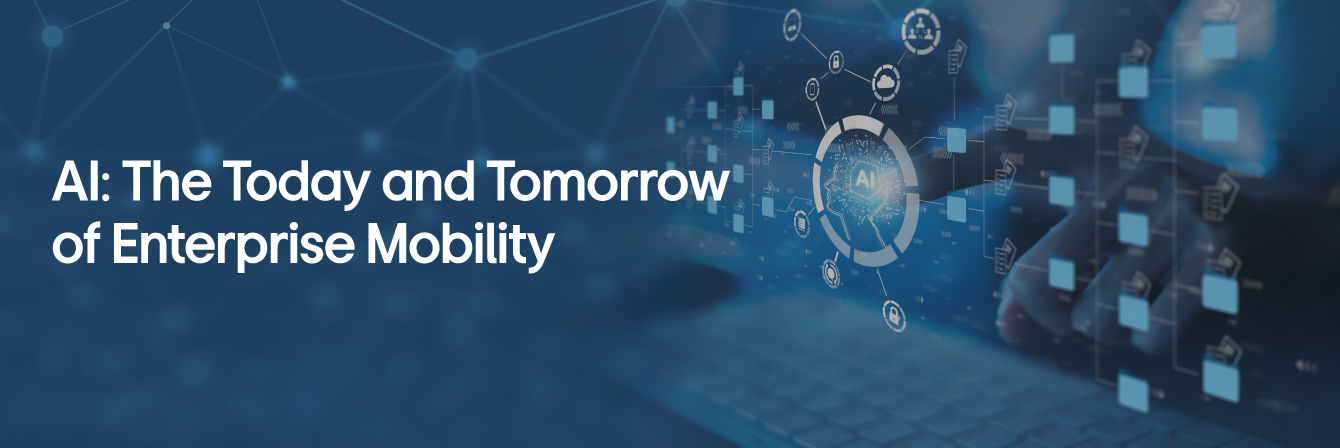
The future of mobile device lifecycle management: Transforming through AI
Artificial intelligence (AI) is the today and tomorrow of mobile device lifecycle management. Advancing quickly, AI mobility solutions drive short- and long-term advantages for enterprise mobility programs. Enterprises that haven’t adopted AI are rapidly losing their market competitiveness, while those that have are actively driving innovation.
Read on as we detail AI’s role in today’s mobility programs, including its key benefits and use cases across device lifecycles.
AI's rising influence on mobile device lifecycle management
Traditionally, enterprise mobility programs relied on static, rule-based mobility solutions. While these platforms provided a stable framework for straightforward workflows, they struggled to adapt to complex scenarios without extensive reconfiguration and human intervention. Compared to modern solutions, legacy systems risk creating bottlenecks, increasing support costs, and limiting the enterprise's ability to scale mobility programs across diverse device ecosystems.
AI is central to advanced enterprise mobility platforms. Globally 42% of enterprises have adopted AI, versus 40% still exploring or experimenting. Notably, 59% of early adopters are accelerating investment or deployment. Samsung ZTM’s Virtual Agent—an Agentic AI—is a leading enterprise mobility AI solution. Its benefits include:
1. Device procurement and provisioning
The Virtual Agent can handle the majority of end-user self-service requests without human intervention, significantly decreasing support ticket volume and specialist labor costs. This automation reduces the need for extensive technical staff to manage routine device-related tasks.
2. Increased scalability
As device fleets grow, the Virtual Agent maintains consistent performance without requiring proportional staffing increases. The solution adapts to fluctuating request volumes across global operations without degradation in response times.
3. Enhanced automation
The agentic AI learns to ask appropriate questions and determine optimal actions rather than following rigid scripts. This dynamic intelligence enables the system to handle complex, multi-step mobility workflows without predefined pathways.
4. Advanced real-time visibility and analytics
The Virtual Agent—built with its native ServiceNow integration—provides centralized monitoring of all device activities and statuses across the enterprise ecosystem. Management can gain immediate insights through comprehensive dashboards that track actionable device lifecycle metrics.
5. Limited manual-intensiveness
End users can resolve device issues through natural conversation rather than navigating complex technical procedures. This alleviates IT staff from repetitive tasks to focus on strategic initiatives that drive business value.
6. Strengthened compliance
The Virtual Agent enforces standardized device management processes, creating consistent audit trails. Every action adheres to predefined security protocols and regulatory requirements across all managed devices.
Advanced mobility AI systems, like ZTM’s Virtual Agent, can tailor to individual enterprise needs. While it drives innovation and market competitiveness today, its advancement rate leads us to expect AI to become increasingly fundamental to the success of all enterprise mobility programs.
AI-enhanced mobility: 4 use cases
ZTM’s Virtual Agent offers value across device lifecycles, from procurement and configuration to returns and decommissioning. Its core use cases include streamlined device procurement and provisioning, end user self-service, remote support and control, and compliance.
1. Device procurement and provisioning
Samsung ZTM’s Virtual Agent simplifies hardware management through conversational AI interfaces. End users can request new devices via chat, prompting the agent to handle policy-based approvals, verify inventory availability, coordinate delivery logistics, and more. Similarly, for device exchanges—whether upgrading models or replacing damaged units—the agent generates return labels, tracks outgoing shipments, and provides real-time updates on replacement status.
2. Visibility & self-service
Virtual Agent centralizes device oversight with intuitive self-service capabilities. Researchers associate AI systems with a 50% reduction in support tickets and a 50% acceleration in ticket resolution.
For one Samsung SDS client, ZTM’s Virtual Agent automates 80-90% of self-service requests—including device orders, lost/stolen reports, and returns.
With ZTM’s Virtual Agent, employees can view all assigned mobile devices through a unified portal, including technical specifications and compliance status. For active requests, such as repairs or returns, the agent provides updates on ticket progress, shipping information, and otherwise manually intensive procedures. This transparency eliminates redundant follow-ups and enables end users to resolve issues independently through guided workflows.
3. Remote support and control
ZTM’s Virtual Agent addresses common device challenges with precision. Employees can trigger audible alerts to locate misplaced devices nearby, execute remote unlocks after identity verification, or unenroll devices to revoke enterprise access. Each action follows predefined security protocols, ensuring compliance while minimizing downtime.
4. Security and compliance
ZTM’s Virtual Agent strengthens security across device lifecycles. Modern AI systems cut audit endpoint time by 58% and reduce patch deployment efforts by 50%. ZTM’s integrated mapping tools let end users pinpoint missing assets instantly. If users lose a device, they can immediately lock it remotely or wipe sensitive data—ensuring sensitive information stays protected.
At the end of the device’s lifecycle, the agent coordinates secure returns. Its device EOL use cases include generating shipping labels, confirming asset receipt, and triggering decommissioning workflows—including data sanitization and inventory updates. Through its centralized protocol-based governance, ZTM’s agent ensures compliance with corporate policies and market reduces lifecycle management risks.
Agentic AI: The next AI evolution for mobile lifecycle management
The top barriers to AI deployment across enterprises are limited AI competencies (33%), excessive data complexity (25%), and ethical concerns (23%). ZTM's agentic AI will further address these barriers through dynamic mobility workflows and its simplified integration with existing ServiceNow infrastructure.
Samsung SDS is the first ServiceNow partner to fully leverage ServiceNow’s Built on Now Virtual Agent for mobility. ZTM’s Virtual Agent integrates all device lifecycle workflows seamlessly onto a single platform. ZTM's Virtual Agent goes beyond basic chat automation by integrating directly with enterprise mobility workflows, enabling real-time actions for device management.
To implement ZTM's Virtual Agent, existing ZTM users simply deploy the standalone application from the ServiceNow Store. The prerequisite requirements include ServiceNow Virtual Agent licensing at ITSM Pro tier or above, with allocation for 1,000 conversations per fulfiller.
Learn how AI can enhance your mobility program. Contact Samsung SDS today.
